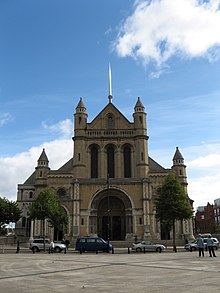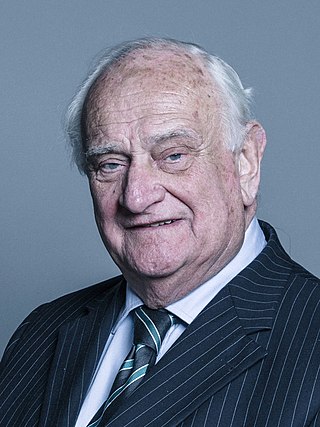
Robert Henry Alexander Eames, Baron Eames, is an Anglican bishop and life peer, who served as Primate of All Ireland and Archbishop of Armagh from 1986 to 2006.

Dromore is a small market town and civil parish in County Down, Northern Ireland. It lies within the local government district of Armagh City, Banbridge and Craigavon. It is 19 miles (31 km) southwest of Belfast, on the A1 Belfast–Dublin road. The 2011 Census recorded a population of 6,395.
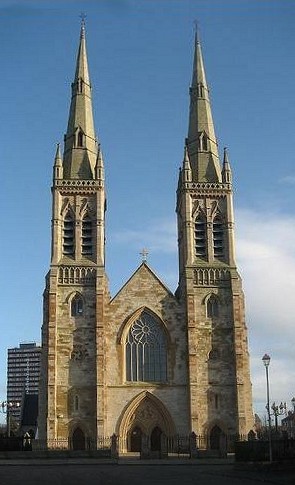
The Diocese of Down and Connor, is a Latin Church ecclesiastical territory or diocese of the Catholic Church in Northern Ireland. It is one of eight suffragan dioceses in the ecclesiastical province of the metropolitan Archdiocese of Armagh. The See is vacant; Bishop Donal McKeown is currently the Apostolic Administrator pending the appointment of a new bishop.
Saint Colmán of Dromore, also known by the pet form Mocholmóc, was a 6th-century Irish saint.
The Bishop of Connor is an episcopal title which takes its name after the village of Connor in County Antrim, Northern Ireland. The title is currently used by the Church of Ireland, but in the Roman Catholic Church it has been united with another bishopric.
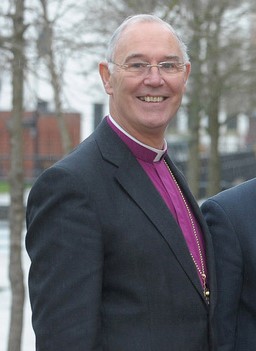
Alan Edwin Thomas Harper, is a retired Anglican bishop. He served in the Church of Ireland as Archbishop of Armagh and Primate of All Ireland from 2007 to 2012.

The Diocese of Dromore is a Latin Church diocese of the Catholic Church in Northern Ireland. It is one of eight suffragan dioceses which are subject to the Metropolitan Archdiocese of Armagh.

Harold Creeth Miller is a retired Irish Anglican bishop. He served as bishop of the Diocese of Down and Dromore in the Church of Ireland. Coming from a Methodist background, he was elected bishop in 1997 and was considered to represent an evangelical position within the Church.

The Diocese of Down and Dromore is a diocese of the Church of Ireland in the south east of Northern Ireland. It is in the ecclesiastical province of Armagh. The geographical remit of the diocese covers half of the City of Belfast to the east of the River Lagan and the part of County Armagh east of the River Bann and all of County Down.
The Bishop of Down and Dromore is the Ordinary of the Church of Ireland Diocese of Down and Dromore in the Province of Armagh. The diocese is situated in the north east of Ireland, which includes all of County Down, about half of the city of Belfast, and some parts of County Armagh east of the River Bann.
The Bishop of Down, Connor and Dromore was the Ordinary of the Church of Ireland diocese of Down, Connor and Dromore; comprising all County Down and County Antrim, including the city of Belfast.
William Reeves was an Irish antiquarian and the Church of Ireland Bishop of Down, Connor and Dromore from 1886 until his death. He was the last private keeper of the Book of Armagh and at the time of his death was President of the Royal Irish Academy.

Charles Frederick D'Arcy was a Church of Ireland bishop. He was the Bishop of Clogher from 1903 to 1907 when he was translated to become Bishop of Ossory, Ferns and Leighlin before then becoming the Bishop of Down, Connor and Dromore. He was then briefly the Archbishop of Dublin and finally, from 1920 until his death, Archbishop of Armagh. He was also a theologian, author and botanist.
Robert Leslie was an Anglican prelate who served in the Church of Ireland as the Bishop of Dromore (1660–61), then Bishop of Raphoe (1661–71), and finally Bishop of Clogher (1671–72).
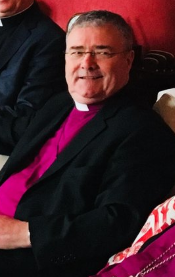
Francis John McDowell is an Anglican bishop, who is the current Church of Ireland Archbishop of Armagh and Primate of All Ireland.

Dromore Cathedral, formally The Cathedral Church of Christ the Redeemer, Dromore, is one of two cathedral churches in the Diocese of Down and Dromore of the Church of Ireland. It is situated in the small town of Dromore, County Down, Northern Ireland, in the ecclesiastical province of Armagh.
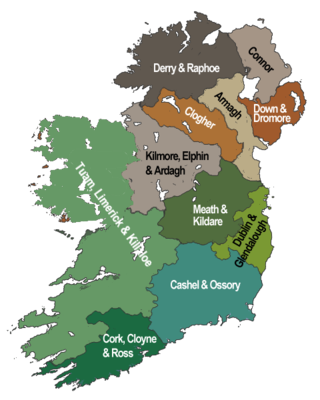
The Archdeacon of Armagh is a senior ecclesiastical officer within the Anglican Diocese of Armagh. The Archdeacon is responsible for the disciplinary supervision of the clergy within the Diocese.
George Thomas William Davison is a priest of the Church of Ireland. Since 2020, he has served as the Bishop of Connor.



